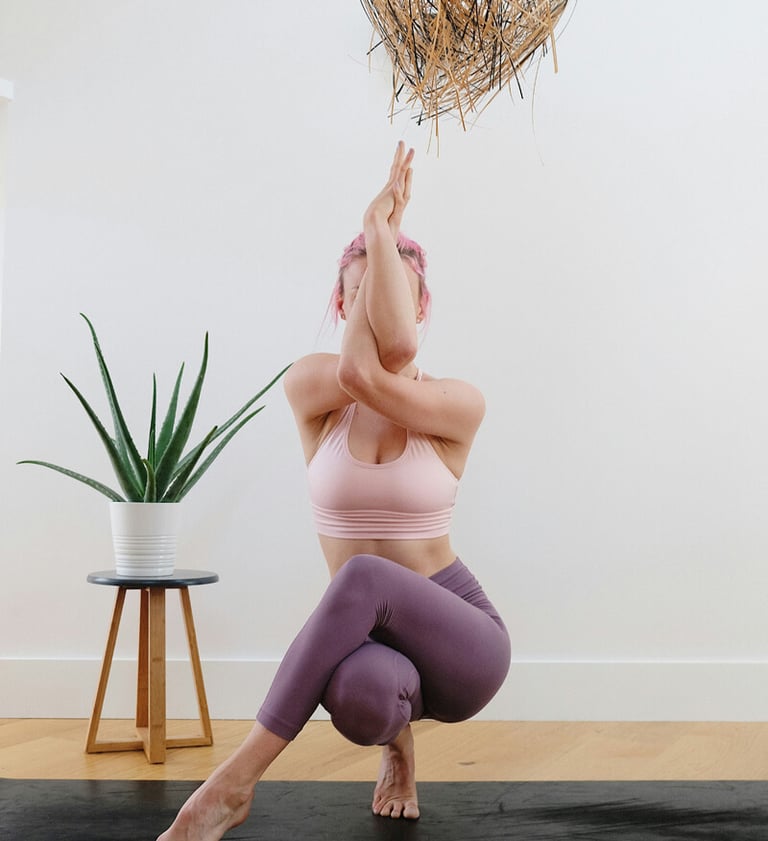

Yoga and Strength Training
How to Combine Both Without Overtraining
Why You Don’t Have to Choose Between Flexibility and Strength
You stretch on Monday, lift on Tuesday, and by Thursday you’re wondering if your sore hamstrings are from yoga or deadlifts. Combining yoga and strength training seems like a wellness jackpot—until fatigue creeps in or your progress stalls. But what if the problem isn’t the practices themselves, but how you're structuring your week?
Pairing yoga and strength training can be a powerful combination. Yoga enhances mobility, balance, and nervous system regulation. Strength training builds muscular power, stability, and functional resilience. Together, they can reduce injury risk and support longevity in training. But the secret is in the timing, intensity, and intention behind your split.
The Benefits of Combining Yoga and Strength Training
Strength Meets Stability—and Mobility
Strength training is essential for building muscle, enhancing bone density, and improving physical performance. It involves progressive overload—gradually increasing resistance to stimulate adaptation. However, traditional lifting patterns can sometimes lead to shortened, tight muscles and imbalances, especially if movement quality is overlooked.
That’s where yoga enters the picture—not as an alternative to strength training, but as a vital complement.
Many lifters experience:
Tight hips from repeated squatting and sitting
Rounded shoulders due to bench pressing and desk posture
Limited ankle dorsiflexion, reducing squat depth and increasing compensations
Asymmetrical patterns, especially from dominant-side bias
Yoga addresses these issues by:
Lengthening chronically tight muscles
Improving joint control through active flexibility (mobility)
Strengthening smaller stabilizer muscles often ignored in compound lifts
Enhancing proprioception (your body’s ability to sense position and movement)
Physiological Synergy
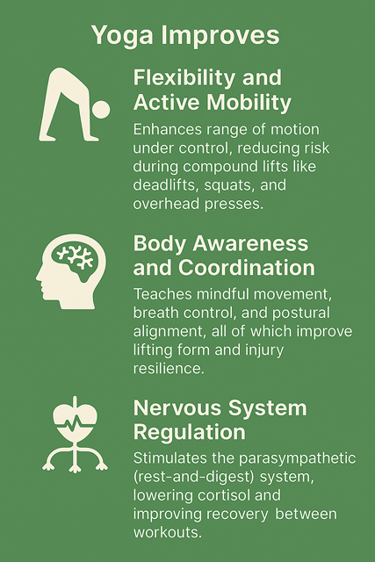

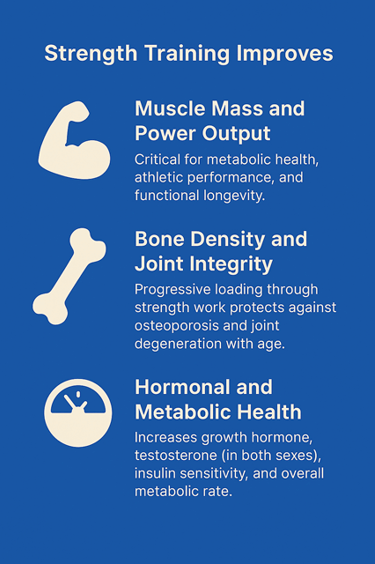

A Symbiotic Relationship
When yoga and strength training are combined intelligently, they form a feedback loop that enhances both modalities:
Lifters become more mobile and balanced, allowing for better form, deeper ranges of motion, and fewer injuries.
Yogis develop strength and structural resilience, supporting their joints and enabling more advanced or sustained poses safely.
Rather than being at odds, these two disciplines support and magnify each other’s benefits. Think of yoga as joint prep and recovery for strength work, and strength training as the structural engine behind deeper, safer yoga practice.
The result? A more resilient, well-rounded, and long-lasting body—with fewer injuries and better overall performance, whether in the gym, on the mat, or in daily life.
Yoga vs. Strength Training – Benefits Comparison
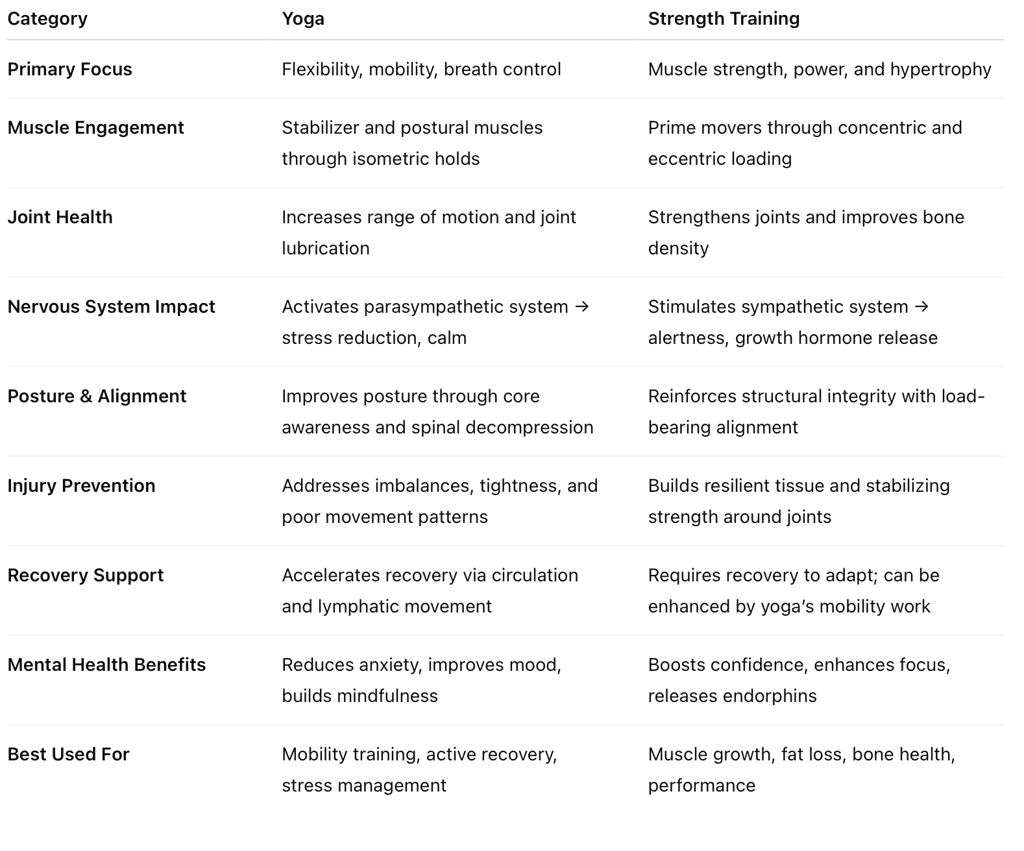

Why Overtraining Happens (and How to Avoid It)
Doing both disciplines back-to-back without planning can lead to overtraining—a state where performance declines due to excessive workload and inadequate recovery.
Signs of overtraining:
Persistent fatigue
Sleep disruption
Elevated resting heart rate
Plateaued strength gains
Increased injuries or joint pain
Yoga may feel like rest, but depending on the style (think Power or Vinyasa), it can actually increase systemic fatigue. Likewise, strength training multiple times per week with poor recovery makes your nervous system more prone to burnout.
Weekly Split Options: How to Combine Yoga and Lifting
A balanced weekly split is your best defense against overtraining. The right split depends on your goals, current fitness level, and the style of yoga you're practicing.
Option 1: 3-Day Strength + 2-Day Yoga (General Fitness & Mobility)
Best for: Most people wanting general strength, mobility, and recovery
Split Example:
Monday: Strength (Full Body A)
Tuesday: Yoga (Mobility or Yin)
Wednesday: Strength (Full Body B)
Thursday: Rest or light walk
Friday: Strength (Full Body C)
Saturday: Yoga (Vinyasa or Hatha)
Sunday: Rest
This format spaces lifting and yoga sessions so muscles and connective tissue get adequate time to recover.
Option 2: 4-Day Upper/Lower Split + Short Yoga (Intermediate Lifters)
Best for: Intermediate to advanced lifters with tighter schedules
Split Example:
Monday: Upper Body Strength + 20-min Mobility Yoga
Tuesday: Lower Body Strength
Wednesday: Rest or Breath-Focused Yoga (Yin or Gentle Hatha)
Thursday: Upper Body Strength
Friday: Lower Body Strength + 20-min Recovery Yoga
Saturday: Optional: Full Yoga Session
Sunday: Rest
Use short yoga sessions post-lifting or as active recovery to enhance range of motion without tiring your CNS.
Option 3: Yoga-Centric Plan with Strength Additions (Mobility or Stress Recovery Focus)
Best for: People coming from yoga or recovering from injury
Split Example:
Monday: Yoga (Vinyasa Flow)
Tuesday: Full Body Strength
Wednesday: Yoga (Mobility or Breathwork)
Thursday: Rest
Friday: Full Body Strength
Saturday: Yoga (Restorative or Yin)
Sunday: Rest
This prioritizes movement quality and stress regulation while still building muscular strength.
Matching Yoga Styles to Training Goals
Not all yoga is created equal. To maximize results, match your yoga style to the goal of your strength session or recovery needs.
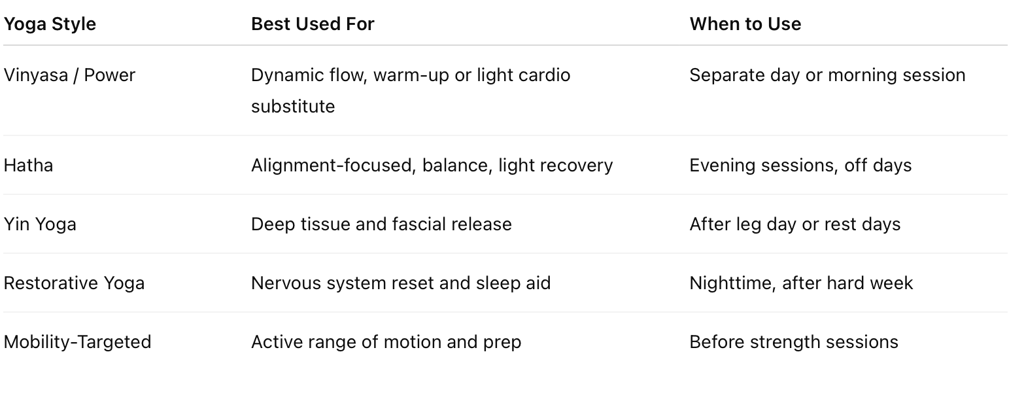

Key Mobility Benefits of Yoga for Lifters
Mobility isn't just about touching your toes—it’s about maintaining control through a full, functional range of motion, especially under load. This is what separates true mobility from passive flexibility. And this is where yoga becomes a game-changer for lifters.
Yoga trains active mobility by incorporating strength, breath control, and dynamic range of motion. The result? Better movement mechanics, reduced injury risk, and improved performance across all compound lifts.
Let’s break down the specific mobility gains yoga provides—and how each one directly impacts your lifting:
🟣 Hip Mobility → Deeper, More Stable Squats and Lunges
Tight hip flexors, adductors, or hamstrings can limit your squat depth and create compensations in your pelvis or lower back.
Yoga Poses That Help: Pigeon Pose, Lizard Lunge, Garland Pose (Malasana), Warrior II
Lifting Translation: Deeper squats with proper spinal alignment and improved glute activation; reduced anterior pelvic tilt
🔵 Shoulder Stability → Safer Pressing and Pulling Movements
Most lifters over-develop the front delts and chest, leading to rounded shoulders and poor scapular control. Yoga promotes shoulder retraction, external rotation, and scapular mobility.
Yoga Poses That Help: Dolphin Pose, Downward Dog, Cow Face Arms, Reverse Prayer
Lifting Translation: Healthier overhead presses and rows, reduced shoulder impingement, and better bench press lockout
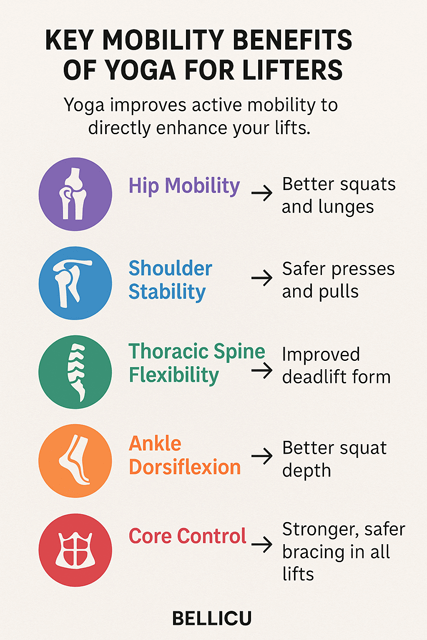

🟠 Ankle Dorsiflexion → Squat Depth and Knee Health
Limited ankle mobility causes the heels to lift in squats and forces the knees to cave in. Yoga improves dorsiflexion, eversion, and overall ankle integrity.
Yoga Poses That Help: Low Lunge with Heel Lift, Deep Squat (Malasana), Toe Squat
Lifting Translation: Improved squat depth, reduced forward lean, more stable lunges and step-ups
🔴 Core Control and Breath Integration → Safer Bracing Under Load
Yoga teaches diaphragmatic breathing and deep core engagement (e.g., via Uddiyana Bandha). These skills transfer directly into stronger bracing during heavy lifts.
Yoga Poses That Help: Plank variations, Boat Pose, Forearm Balance (even just setting up), and slow controlled breathwork
Lifting Translation: Increased intra-abdominal pressure, safer spinal positioning during deadlifts and squats, better control under tension
🟢 Thoracic Spine Flexibility → Better Deadlift and Overhead Mechanics
The thoracic spine (mid-back) often becomes stiff due to desk jobs or heavy anterior loading. Yoga restores extension and rotation through this region.
Yoga Poses That Help: Cat-Cow, Thread the Needle, Sphinx, Cobra
Lifting Translation: Better spinal alignment in deadlifts, snatches, and cleans; reduced rounding and improved scapular positioning
Why This Matters for Strength Athletes
When these mobility areas are improved, you don’t just move better—you move safer and with more efficiency. This means:
Fewer compensations and injury risks
Better muscle recruitment (especially glutes, lats, and core)
Greater joint integrity under load
By integrating yoga into your weekly plan—even just twice per week—you’re investing in long-term lifting success.
Common Mistakes to Avoid When Combining Yoga and Strength Training
Even with the best intentions, combining yoga and strength training can backfire if your plan lacks strategy. These common mistakes often lead to stalled progress, fatigue, or injury. Here’s how to avoid them:
1. Treating Yoga Like Cardio Every Day
Styles like Power Yoga and fast-paced Vinyasa may feel “light,” but they’re far from passive. These sessions can elevate your heart rate, challenge your muscles with isometric holds, and add significant cumulative fatigue—especially if done daily alongside heavy lifting.
Why it’s a problem:
Excessive sympathetic nervous system activation (fight-or-flight mode)
Elevated cortisol levels and suppressed recovery
Increased risk of overuse injuries and nervous system burnout
What to do instead:
Alternate between intense yoga (e.g., Vinyasa) and restorative forms (e.g., Yin or Hatha)
Treat Power Yoga as a legit workout day, not a “rest” filler
Prioritize intentional recovery, not just movement volume
2. Skipping Rest Days
If your week includes strength training 3–4 times, plus multiple yoga sessions, it’s easy to think, “I’m fine, it’s just stretching.” But the truth is, your central nervous system, joints, and soft tissues still need time to rebuild and adapt.
Why it’s a problem:
Chronic stress and muscle breakdown without adequate repair
Sleep disruption, hormonal imbalance, and performance plateaus
Increased mental fatigue and decreased training motivation
What to do instead:
Schedule at least one full rest day per week—no yoga, no lifting
Use Yin or breath-based yoga (not flow styles) on recovery days
Monitor HRV, sleep, or resting heart rate as markers of fatigue
3. Poor Exercise Order and Timing
Doing a long, challenging yoga session that targets the same muscles you plan to max out later in the gym? That’s a recipe for fatigued movement patterns and impaired strength output.
Why it’s a problem:
Fatigued stabilizers compromise joint control under load
Muscles may be overstretched before lifting, leading to poor force production
Mental focus and bracing can suffer post-yoga
What to do instead:
Yoga before strength? Only if it's short, mobility-based, and doesn’t fatigue target muscles
Strength first, yoga later? Ideal if yoga focuses on recovery and down-regulation (e.g., Hatha, Yin)
Time sessions with 4–6 hours of recovery in between if doing both on the same day
4. Not Eating Enough for Recovery
Many people accidentally undereat when adding yoga to a strength training routine, especially if their goal is fat loss. But yoga—especially dynamic flows—still burns calories and adds volume to your weekly output.
Why it’s a problem:
Insufficient fuel leads to muscle breakdown and stalled hypertrophy
Hormonal disruption (thyroid, cortisol, estrogen/testosterone)
Increased susceptibility to overtraining symptoms (e.g., mood dips, sleep issues)
What to do instead:
Adjust your calories upward slightly if adding yoga to a lifting plan
Prioritize protein intake (1.6–2.2g/kg body weight) to support muscle repair
Use yoga as a chance to enhance digestion, not starve through effort
Bonus Tip: Track How You Feel, Not Just What You Do
Even if your split looks balanced on paper, listen to your body's feedback. If you're:
Struggling with joint aches or persistent DOMS
Sleeping poorly or waking up tired
Losing enthusiasm for workouts
…it might be time to pull back, deload, or swap intense sessions for recovery-focused practices.
Combining yoga and strength training is about synergy, not stacking. Respect each modality’s recovery needs—and your own.
Injury Prevention Through Intelligent Programming
Combining yoga and strength training can significantly reduce your injury risk—but only when it’s programmed with intention. Too many people assume more is better, but the real key is how you integrate both modalities. Injury prevention isn’t just about doing “safe” exercises—it’s about doing the right movement at the right time, with the right intensity.
How to Train Smarter, Not Just Harder:
1. Warm Up with Mobility, Not Static Stretching
Traditional static stretches before lifting can reduce force output and increase injury risk when muscles are placed under load.
Instead, use active mobility drills or yoga-inspired flows (like Cat-Cow, Downward Dog to Cobra, or Low Lunges) to prep your joints and nervous system for movement.
Why it matters: Mobilizing joints before lifting enhances stability, improves range of motion, and primes neural pathways for performance.
2. Use Yoga to Down-Regulate After Strength Training
High-intensity lifting spikes cortisol and puts your body in a sympathetic (fight-or-flight) state. To recover fully, you need to activate the parasympathetic nervous system (rest and digest).
Post-workout or evening sessions of Yin or Restorative Yoga can:
Lower heart rate and blood pressure
Improve HRV and sleep quality
Reduce inflammation and perceived muscle soreness
3. Avoid Overstretching—Especially After Heavy Lifting
Lifting places small micro-tears in muscle fibers. Going into deep static poses immediately afterward (especially passive hip openers or backbends) may worsen this by overstretching already fatigued tissues.
Tip: Wait several hours post-lift (or train yoga the next day) if your practice includes deep flexibility work.
4. Prioritize Technique and Breath in Both Modalities
It’s not just what you do, but how you do it. In both strength training and yoga:
Controlled breathing improves muscular engagement and stability
Good form reduces compensations that stress joints
Focusing on quality > quantity keeps your nervous system calm and injury-free
Holding a Warrior II with proper alignment is as much about focus as it is about mobility—just like a clean barbell front squat.
5. Listen to Your Body, Not Your Ego
This might be the most important point of all.
Some days you’ll need to push. Other days, your body will crave rest. Trying to muscle through a barbell complex or force a deep twist in yoga when you're already fatigued is a fast track to strains, tears, or burnout.
🔴 Warning signs to respect:
Persistent joint pain or tendon tightness
A sharp decrease in motivation or strength
Sleep disruption or irritability
Heart rate staying elevated long after workouts
Injury prevention isn’t about playing it safe—it’s about training intelligently so you can keep showing up strong, mobile, and pain-free long-term.
Who Benefits Most from This Combo?
The integration of yoga and strength training isn’t just for yogis or gym rats—it’s a versatile strategy that serves a wide range of goals and populations. Whether you’re seeking performance, recovery, or resilience, this hybrid model delivers.
1. Lifters with Poor Mobility or Recurring Joint Pain
Tight hips? Limited ankle mobility? Shoulder impingement?
Yoga can correct underlying movement dysfunctions that lifting alone may reinforce. Adding mobility-based yoga 2–3x per week can significantly reduce wear and tear over time.
2. Yoga Practitioners Who Want Strength and Bone Density
Yoga is fantastic for balance, control, and flexibility—but it lacks progressive loading, which is key for:
Building lean mass
Boosting metabolism
Preventing age-related bone loss
Adding two days of strength training can elevate your yoga game and prevent injury by reinforcing joint stability.
3. Busy Professionals Needing Stress Relief + Physical Gains
Work stress plus sedentary days can wreck posture and recovery. Yoga helps regulate the nervous system, while strength training boosts productivity, confidence, and energy.
This combo is time-efficient and balances out the mental and physical strain of daily life.
4. Older Adults Seeking Longevity and Injury Resilience
As we age, we lose both muscle mass (sarcopenia) and mobility. Combining yoga and strength slows this decline dramatically.
Benefits include:
Stronger bones and joints
Better balance (fall prevention)
Enhanced circulation and mobility
Improved sleep and cognitive function
5. Athletes Looking to Improve Movement Efficiency
Tightness and asymmetries can limit speed, power, and precision in sport. Yoga offers active recovery, joint control, and movement pattern correction—making you a more efficient, injury-resistant athlete.
Many elite athletes (from NFL players to Olympic lifters) now include yoga in their training for precisely these reasons.
Final Thoughts: Strong, Supple, and Sustainable
Combining yoga and strength training isn’t about doing more—it’s about doing smarter. When structured well, yoga can help you lift better, move freer, and feel more balanced. Whether you’re chasing PRs, chasing kids, or simply want to feel good in your body, the right weekly split can support your goals—without tipping into burnout.
The gym gives you power. The mat gives you presence. Together? They build a body that lasts.
References
Flexibility and Balance in Athletes
Study: Impact of 10-weeks of yoga practice on flexibility and balance of male college athletes
Source: International Journal of Yoga (Polsgrove et al., 2016)
Link: https://pubmed.ncbi.nlm.nih.gov/26865768/
Summary: This study demonstrated that a 10-week yoga program significantly improved flexibility and balance in male college athletes, suggesting benefits for athletic performance.
Yoga for Athletes
Study: Yoga for Athletes: Prevent Injuries and Muscle Pain
Source: Yoga Journal (2024)
Link: https://www.yogajournal.com/practice/yoga-for-athletes/
Summary: This article discusses how yoga can help athletes prevent injuries and muscle pain, emphasizing its role in enhancing performance and recovery.
Yoga in Sports Medicine and Rehabilitation
Study: Yoga as Part of Sports Medicine and Rehabilitation
Source: International Journal of Yoga (Krishnamurthy, 2023)
Link: https://pubmed.ncbi.nlm.nih.gov/38204776/
Summary: This editorial discusses the integration of yoga into sports medicine, highlighting its potential benefits in rehabilitation and injury prevention.
Yoga for Older Adults' Mobility
Study: Yoga to prevent mobility limitations in older adults: feasibility of a randomized controlled trial
Source: BMC Geriatrics (Groessl et al., 2018)
Link: https://pubmed.ncbi.nlm.nih.gov/30541474/
Summary: This pilot study found that yoga is a feasible and safe intervention for sedentary older adults at risk of mobility limitations, warranting further research.
Neurobiological and Anti-Aging Benefits of Yoga
Study: Neurobiological and anti-aging benefits of yoga
Source: Experimental Gerontology (Chen, 2024)
Link: https://pubmed.ncbi.nlm.nih.gov/39173784/
Summary: This review highlights how consistent yoga practice can improve joint function, flexibility, and overall mobility, contributing to healthy aging.
Overtraining Syndrome in Athletes
Study: Overtraining syndrome: a practical guide
Source: Sports Health (Kreher & Schwartz, 2012)
Link: https://pubmed.ncbi.nlm.nih.gov/23016079/
Summary: This article provides a comprehensive overview of overtraining syndrome, including its symptoms, diagnosis, and prevention strategies.
Yoga's Impact on Muscular Endurance
Study: Effects of yoga practice on muscular endurance in young women
Source: Journal of Bodywork and Movement Therapies (2016)
Link: https://pubmed.ncbi.nlm.nih.gov/26850809/
Summary: This study found that yoga practice improved upper limb and abdominal muscular endurance in young women, indicating its effectiveness in enhancing muscular fitness.
